HND Business Strategy: Volkswagen AG's Strategic Analysis Report
VerifiedAdded on 2020/06/06
|20
|4428
|368
Report
AI Summary
This report provides a comprehensive analysis of Volkswagen AG's business strategy. It begins with an introduction to business strategy and then delves into an organizational audit using SWOT analysis to assess Volkswagen's strengths, weaknesses, opportunities, and threats. An environmental audit, including micro and macro environmental factors (PESTEL analysis), is conducted to understand the external forces impacting the company. The significance of stakeholder analysis is discussed, and a stakeholder mapping exercise is performed. The report then proposes a new strategy for Volkswagen AG, considering market coverage, product diversification, innovation, and corporate social responsibility. Alternative strategies, such as market entry, substantive growth, and retrenchment, are evaluated for their appropriateness. The selected strategy is justified, and implementation details, including roles, resources, and SMART targets, are outlined. The report concludes with a summary of findings and recommendations for the company's strategic direction.
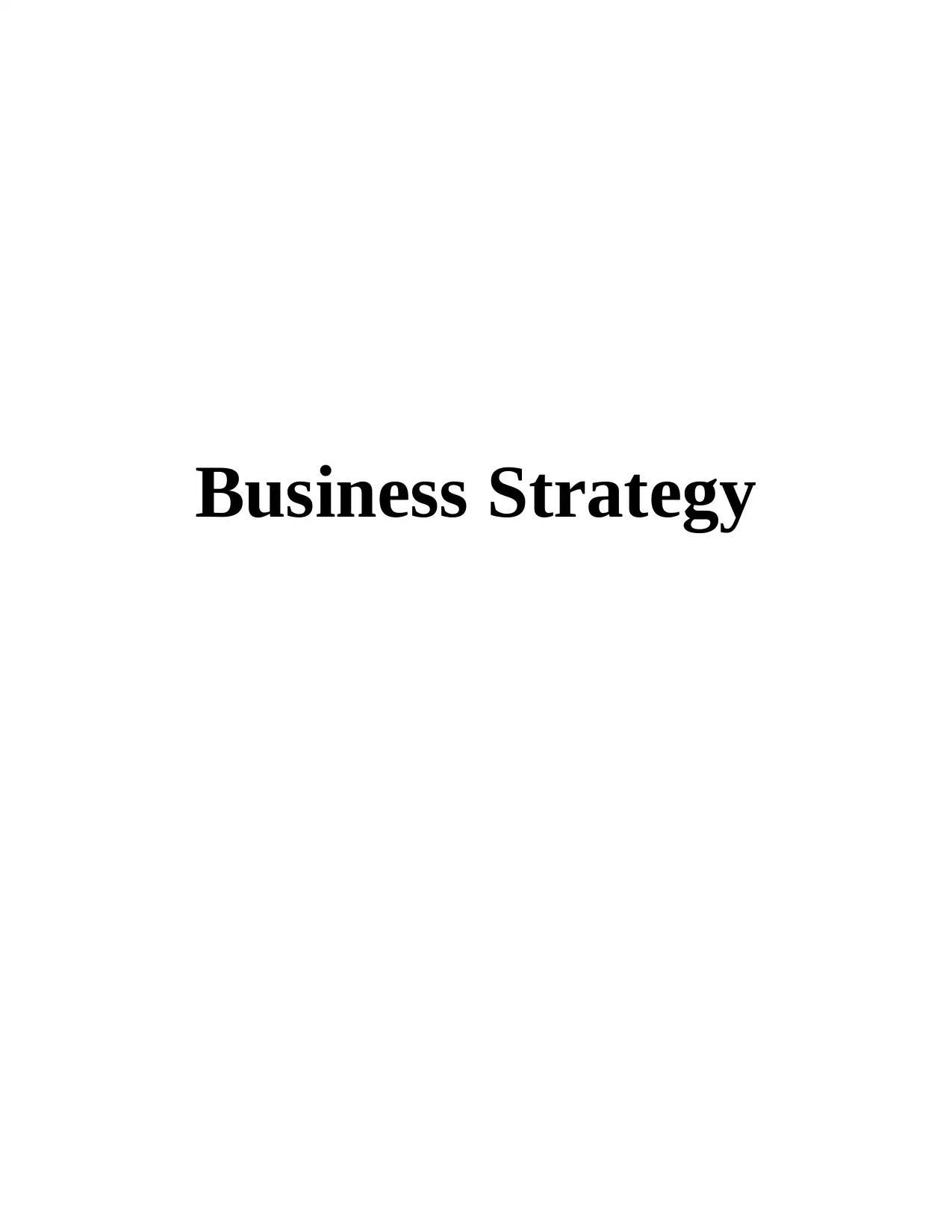
Business Strategy
Paraphrase This Document
Need a fresh take? Get an instant paraphrase of this document with our AI Paraphraser
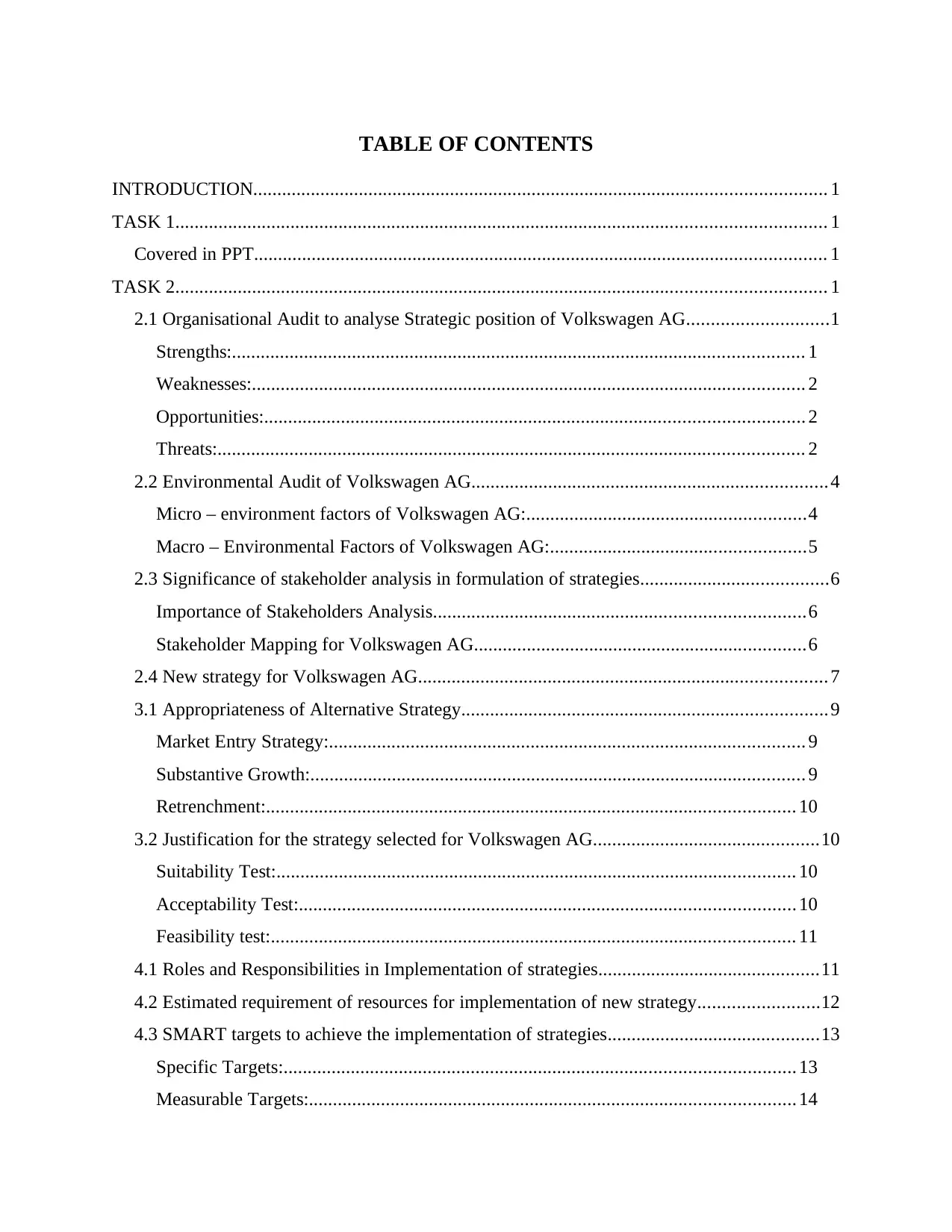
TABLE OF CONTENTS
INTRODUCTION....................................................................................................................... 1
TASK 1....................................................................................................................................... 1
Covered in PPT....................................................................................................................... 1
TASK 2....................................................................................................................................... 1
2.1 Organisational Audit to analyse Strategic position of Volkswagen AG.............................1
Strengths:....................................................................................................................... 1
Weaknesses:................................................................................................................... 2
Opportunities:................................................................................................................ 2
Threats:.......................................................................................................................... 2
2.2 Environmental Audit of Volkswagen AG..........................................................................4
Micro – environment factors of Volkswagen AG:..........................................................4
Macro – Environmental Factors of Volkswagen AG:.....................................................5
2.3 Significance of stakeholder analysis in formulation of strategies.......................................6
Importance of Stakeholders Analysis.............................................................................6
Stakeholder Mapping for Volkswagen AG.....................................................................6
2.4 New strategy for Volkswagen AG..................................................................................... 7
3.1 Appropriateness of Alternative Strategy............................................................................9
Market Entry Strategy:................................................................................................... 9
Substantive Growth:....................................................................................................... 9
Retrenchment:.............................................................................................................. 10
3.2 Justification for the strategy selected for Volkswagen AG...............................................10
Suitability Test:............................................................................................................ 10
Acceptability Test:....................................................................................................... 10
Feasibility test:............................................................................................................. 11
4.1 Roles and Responsibilities in Implementation of strategies..............................................11
4.2 Estimated requirement of resources for implementation of new strategy.........................12
4.3 SMART targets to achieve the implementation of strategies............................................13
Specific Targets:.......................................................................................................... 13
Measurable Targets:..................................................................................................... 14
INTRODUCTION....................................................................................................................... 1
TASK 1....................................................................................................................................... 1
Covered in PPT....................................................................................................................... 1
TASK 2....................................................................................................................................... 1
2.1 Organisational Audit to analyse Strategic position of Volkswagen AG.............................1
Strengths:....................................................................................................................... 1
Weaknesses:................................................................................................................... 2
Opportunities:................................................................................................................ 2
Threats:.......................................................................................................................... 2
2.2 Environmental Audit of Volkswagen AG..........................................................................4
Micro – environment factors of Volkswagen AG:..........................................................4
Macro – Environmental Factors of Volkswagen AG:.....................................................5
2.3 Significance of stakeholder analysis in formulation of strategies.......................................6
Importance of Stakeholders Analysis.............................................................................6
Stakeholder Mapping for Volkswagen AG.....................................................................6
2.4 New strategy for Volkswagen AG..................................................................................... 7
3.1 Appropriateness of Alternative Strategy............................................................................9
Market Entry Strategy:................................................................................................... 9
Substantive Growth:....................................................................................................... 9
Retrenchment:.............................................................................................................. 10
3.2 Justification for the strategy selected for Volkswagen AG...............................................10
Suitability Test:............................................................................................................ 10
Acceptability Test:....................................................................................................... 10
Feasibility test:............................................................................................................. 11
4.1 Roles and Responsibilities in Implementation of strategies..............................................11
4.2 Estimated requirement of resources for implementation of new strategy.........................12
4.3 SMART targets to achieve the implementation of strategies............................................13
Specific Targets:.......................................................................................................... 13
Measurable Targets:..................................................................................................... 14

Attainable:.................................................................................................................... 14
Relevant:...................................................................................................................... 14
Time Based:................................................................................................................. 14
CONCLUSION.......................................................................................................................... 14
REFERENCES ......................................................................................................................... 16
Relevant:...................................................................................................................... 14
Time Based:................................................................................................................. 14
CONCLUSION.......................................................................................................................... 14
REFERENCES ......................................................................................................................... 16
⊘ This is a preview!⊘
Do you want full access?
Subscribe today to unlock all pages.

Trusted by 1+ million students worldwide
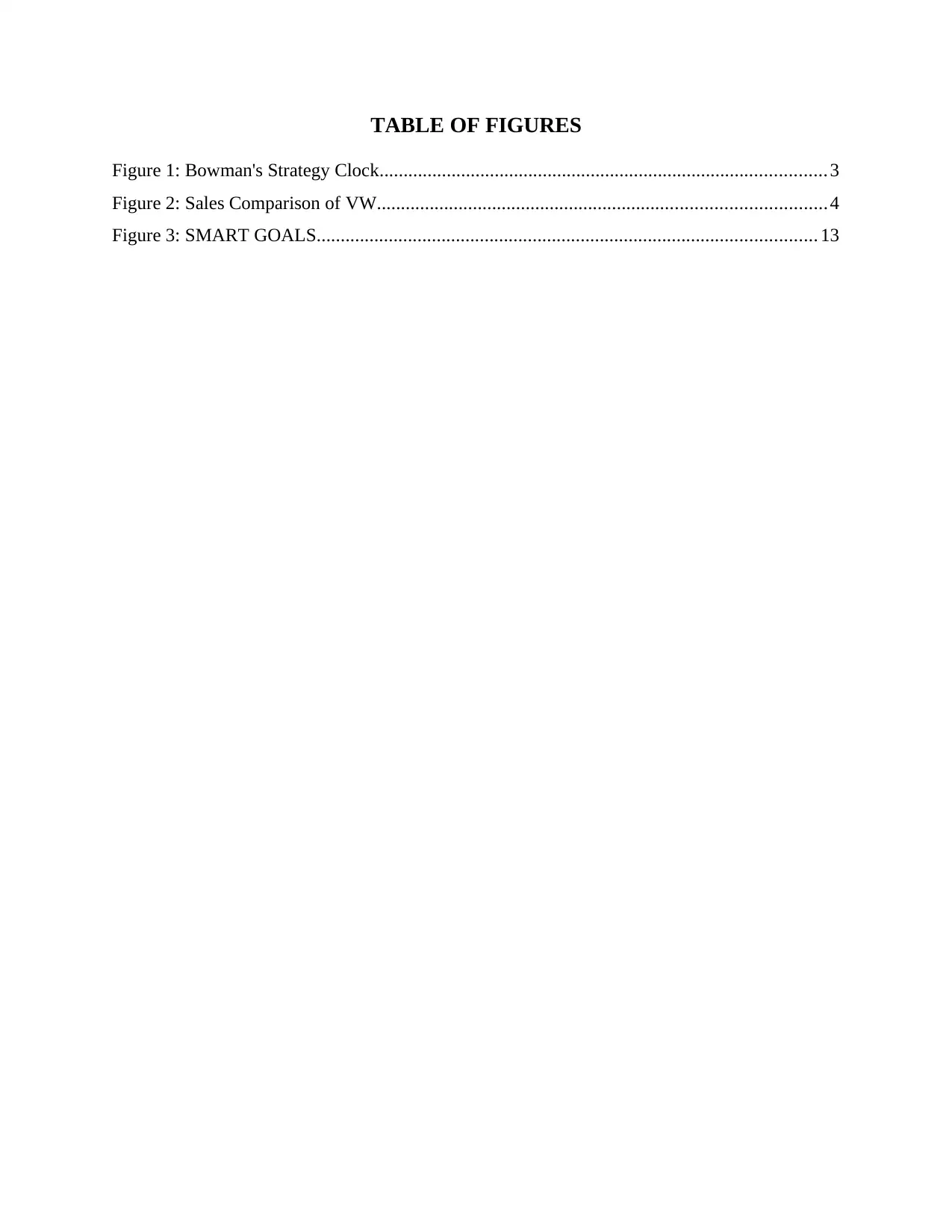
TABLE OF FIGURES
Figure 1: Bowman's Strategy Clock............................................................................................. 3
Figure 2: Sales Comparison of VW.............................................................................................4
Figure 3: SMART GOALS........................................................................................................ 13
Figure 1: Bowman's Strategy Clock............................................................................................. 3
Figure 2: Sales Comparison of VW.............................................................................................4
Figure 3: SMART GOALS........................................................................................................ 13
Paraphrase This Document
Need a fresh take? Get an instant paraphrase of this document with our AI Paraphraser
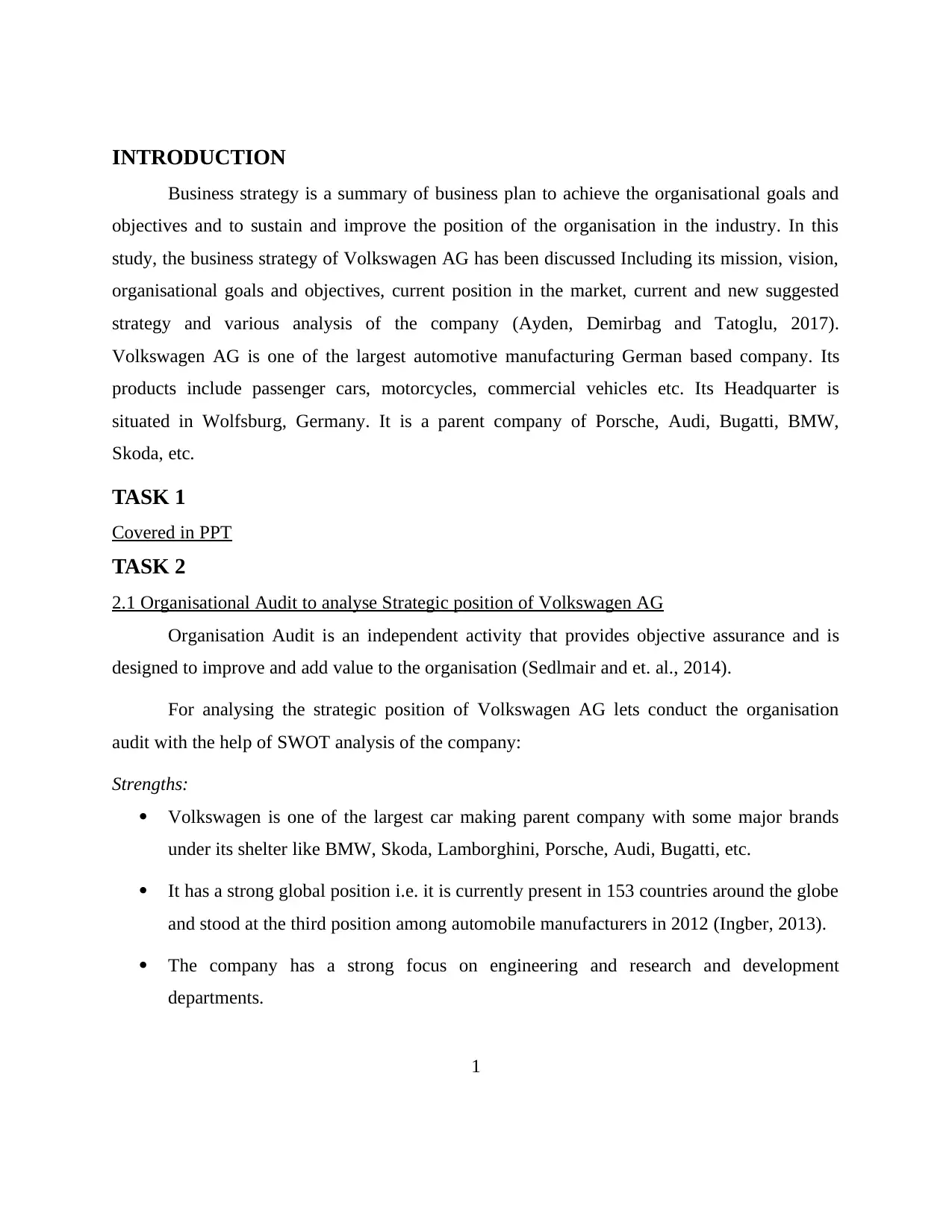
INTRODUCTION
Business strategy is a summary of business plan to achieve the organisational goals and
objectives and to sustain and improve the position of the organisation in the industry. In this
study, the business strategy of Volkswagen AG has been discussed Including its mission, vision,
organisational goals and objectives, current position in the market, current and new suggested
strategy and various analysis of the company (Ayden, Demirbag and Tatoglu, 2017).
Volkswagen AG is one of the largest automotive manufacturing German based company. Its
products include passenger cars, motorcycles, commercial vehicles etc. Its Headquarter is
situated in Wolfsburg, Germany. It is a parent company of Porsche, Audi, Bugatti, BMW,
Skoda, etc.
TASK 1
Covered in PPT
TASK 2
2.1 Organisational Audit to analyse Strategic position of Volkswagen AG
Organisation Audit is an independent activity that provides objective assurance and is
designed to improve and add value to the organisation (Sedlmair and et. al., 2014).
For analysing the strategic position of Volkswagen AG lets conduct the organisation
audit with the help of SWOT analysis of the company:
Strengths:
Volkswagen is one of the largest car making parent company with some major brands
under its shelter like BMW, Skoda, Lamborghini, Porsche, Audi, Bugatti, etc.
It has a strong global position i.e. it is currently present in 153 countries around the globe
and stood at the third position among automobile manufacturers in 2012 (Ingber, 2013).
The company has a strong focus on engineering and research and development
departments.
1
Business strategy is a summary of business plan to achieve the organisational goals and
objectives and to sustain and improve the position of the organisation in the industry. In this
study, the business strategy of Volkswagen AG has been discussed Including its mission, vision,
organisational goals and objectives, current position in the market, current and new suggested
strategy and various analysis of the company (Ayden, Demirbag and Tatoglu, 2017).
Volkswagen AG is one of the largest automotive manufacturing German based company. Its
products include passenger cars, motorcycles, commercial vehicles etc. Its Headquarter is
situated in Wolfsburg, Germany. It is a parent company of Porsche, Audi, Bugatti, BMW,
Skoda, etc.
TASK 1
Covered in PPT
TASK 2
2.1 Organisational Audit to analyse Strategic position of Volkswagen AG
Organisation Audit is an independent activity that provides objective assurance and is
designed to improve and add value to the organisation (Sedlmair and et. al., 2014).
For analysing the strategic position of Volkswagen AG lets conduct the organisation
audit with the help of SWOT analysis of the company:
Strengths:
Volkswagen is one of the largest car making parent company with some major brands
under its shelter like BMW, Skoda, Lamborghini, Porsche, Audi, Bugatti, etc.
It has a strong global position i.e. it is currently present in 153 countries around the globe
and stood at the third position among automobile manufacturers in 2012 (Ingber, 2013).
The company has a strong focus on engineering and research and development
departments.
1
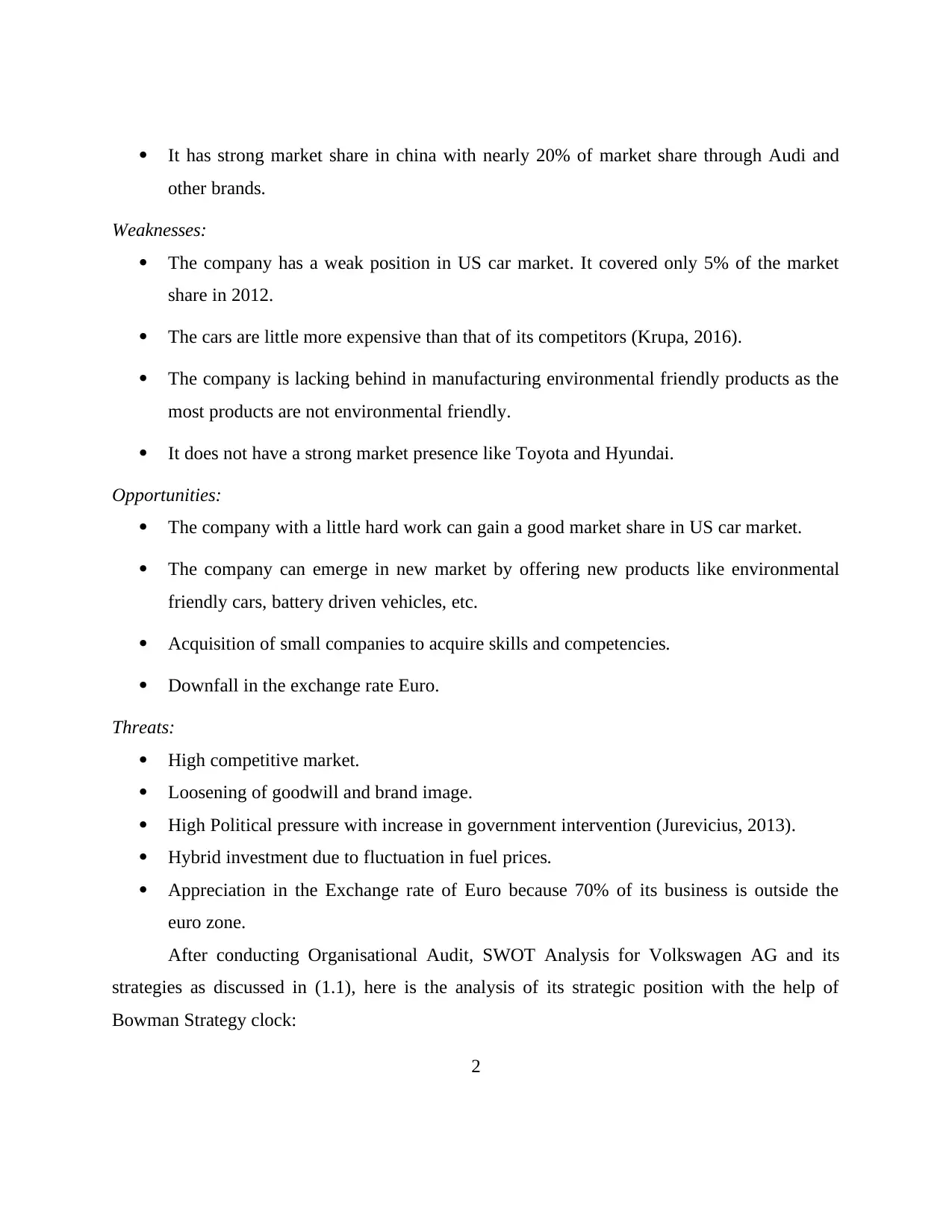
It has strong market share in china with nearly 20% of market share through Audi and
other brands.
Weaknesses:
The company has a weak position in US car market. It covered only 5% of the market
share in 2012.
The cars are little more expensive than that of its competitors (Krupa, 2016).
The company is lacking behind in manufacturing environmental friendly products as the
most products are not environmental friendly.
It does not have a strong market presence like Toyota and Hyundai.
Opportunities:
The company with a little hard work can gain a good market share in US car market.
The company can emerge in new market by offering new products like environmental
friendly cars, battery driven vehicles, etc.
Acquisition of small companies to acquire skills and competencies.
Downfall in the exchange rate Euro.
Threats:
High competitive market.
Loosening of goodwill and brand image.
High Political pressure with increase in government intervention (Jurevicius, 2013).
Hybrid investment due to fluctuation in fuel prices.
Appreciation in the Exchange rate of Euro because 70% of its business is outside the
euro zone.
After conducting Organisational Audit, SWOT Analysis for Volkswagen AG and its
strategies as discussed in (1.1), here is the analysis of its strategic position with the help of
Bowman Strategy clock:
2
other brands.
Weaknesses:
The company has a weak position in US car market. It covered only 5% of the market
share in 2012.
The cars are little more expensive than that of its competitors (Krupa, 2016).
The company is lacking behind in manufacturing environmental friendly products as the
most products are not environmental friendly.
It does not have a strong market presence like Toyota and Hyundai.
Opportunities:
The company with a little hard work can gain a good market share in US car market.
The company can emerge in new market by offering new products like environmental
friendly cars, battery driven vehicles, etc.
Acquisition of small companies to acquire skills and competencies.
Downfall in the exchange rate Euro.
Threats:
High competitive market.
Loosening of goodwill and brand image.
High Political pressure with increase in government intervention (Jurevicius, 2013).
Hybrid investment due to fluctuation in fuel prices.
Appreciation in the Exchange rate of Euro because 70% of its business is outside the
euro zone.
After conducting Organisational Audit, SWOT Analysis for Volkswagen AG and its
strategies as discussed in (1.1), here is the analysis of its strategic position with the help of
Bowman Strategy clock:
2
⊘ This is a preview!⊘
Do you want full access?
Subscribe today to unlock all pages.

Trusted by 1+ million students worldwide
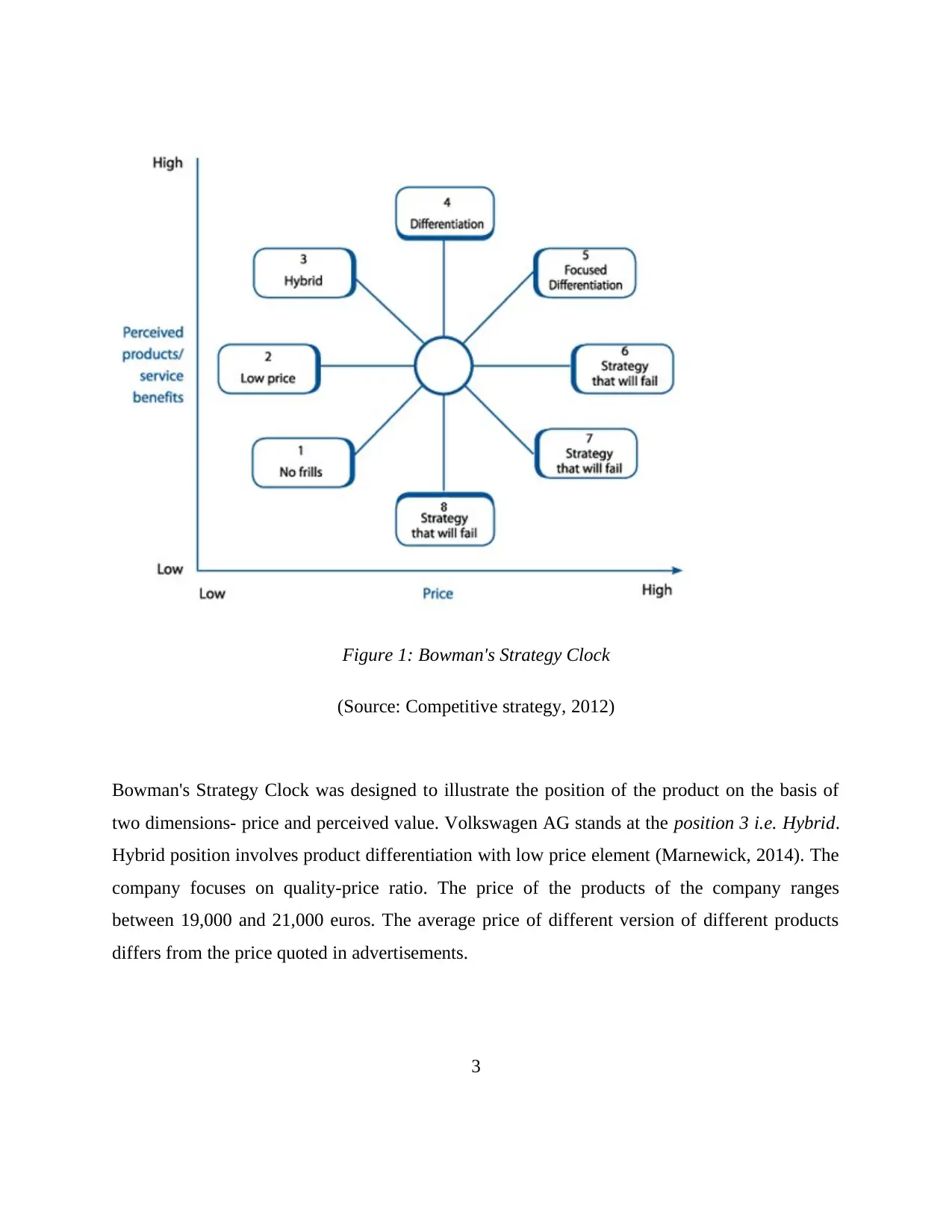
Figure 1: Bowman's Strategy Clock
(Source: Competitive strategy, 2012)
Bowman's Strategy Clock was designed to illustrate the position of the product on the basis of
two dimensions- price and perceived value. Volkswagen AG stands at the position 3 i.e. Hybrid.
Hybrid position involves product differentiation with low price element (Marnewick, 2014). The
company focuses on quality-price ratio. The price of the products of the company ranges
between 19,000 and 21,000 euros. The average price of different version of different products
differs from the price quoted in advertisements.
3
(Source: Competitive strategy, 2012)
Bowman's Strategy Clock was designed to illustrate the position of the product on the basis of
two dimensions- price and perceived value. Volkswagen AG stands at the position 3 i.e. Hybrid.
Hybrid position involves product differentiation with low price element (Marnewick, 2014). The
company focuses on quality-price ratio. The price of the products of the company ranges
between 19,000 and 21,000 euros. The average price of different version of different products
differs from the price quoted in advertisements.
3
Paraphrase This Document
Need a fresh take? Get an instant paraphrase of this document with our AI Paraphraser
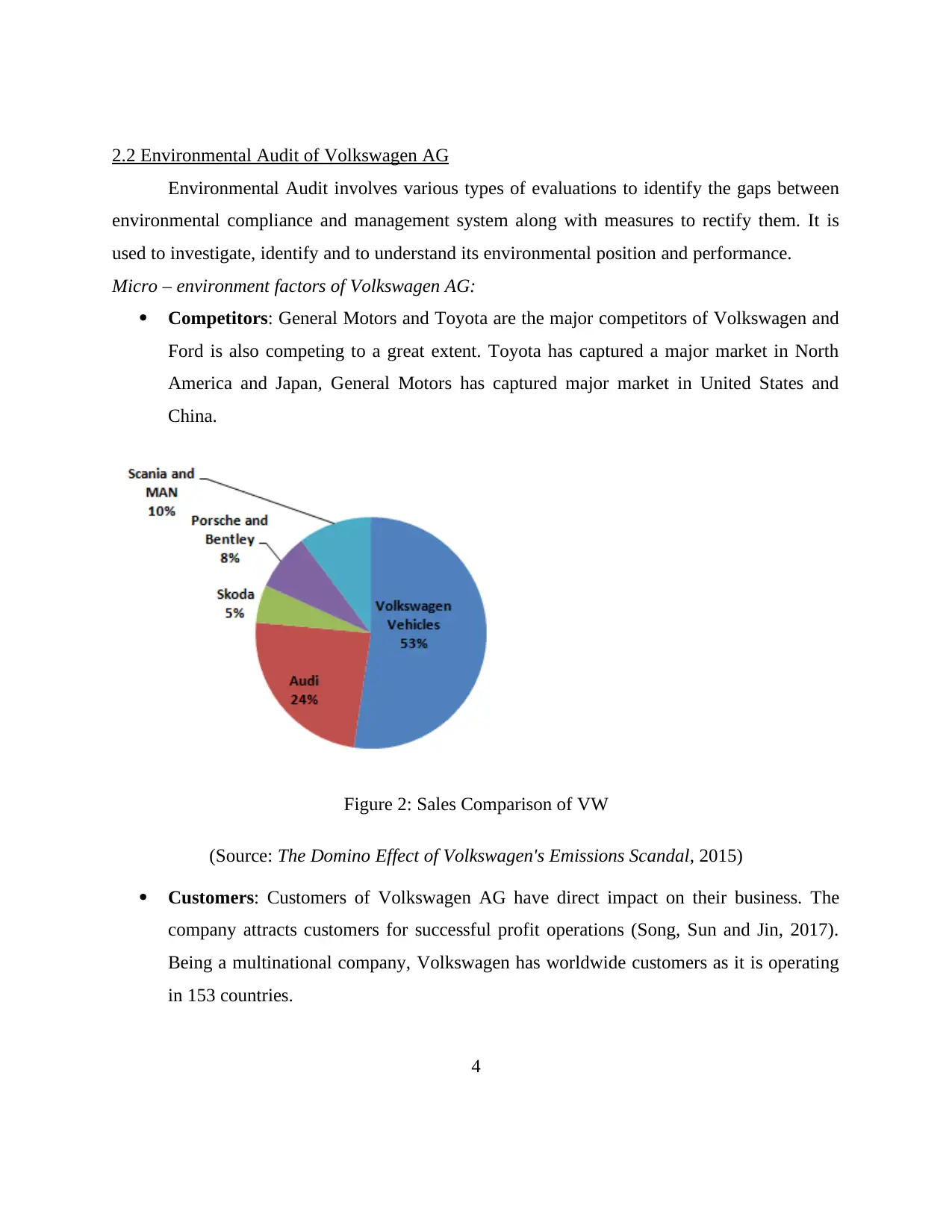
2.2 Environmental Audit of Volkswagen AG
Environmental Audit involves various types of evaluations to identify the gaps between
environmental compliance and management system along with measures to rectify them. It is
used to investigate, identify and to understand its environmental position and performance.
Micro – environment factors of Volkswagen AG:
Competitors: General Motors and Toyota are the major competitors of Volkswagen and
Ford is also competing to a great extent. Toyota has captured a major market in North
America and Japan, General Motors has captured major market in United States and
China.
Figure 2: Sales Comparison of VW
(Source: The Domino Effect of Volkswagen's Emissions Scandal, 2015)
Customers: Customers of Volkswagen AG have direct impact on their business. The
company attracts customers for successful profit operations (Song, Sun and Jin, 2017).
Being a multinational company, Volkswagen has worldwide customers as it is operating
in 153 countries.
4
Environmental Audit involves various types of evaluations to identify the gaps between
environmental compliance and management system along with measures to rectify them. It is
used to investigate, identify and to understand its environmental position and performance.
Micro – environment factors of Volkswagen AG:
Competitors: General Motors and Toyota are the major competitors of Volkswagen and
Ford is also competing to a great extent. Toyota has captured a major market in North
America and Japan, General Motors has captured major market in United States and
China.
Figure 2: Sales Comparison of VW
(Source: The Domino Effect of Volkswagen's Emissions Scandal, 2015)
Customers: Customers of Volkswagen AG have direct impact on their business. The
company attracts customers for successful profit operations (Song, Sun and Jin, 2017).
Being a multinational company, Volkswagen has worldwide customers as it is operating
in 153 countries.
4
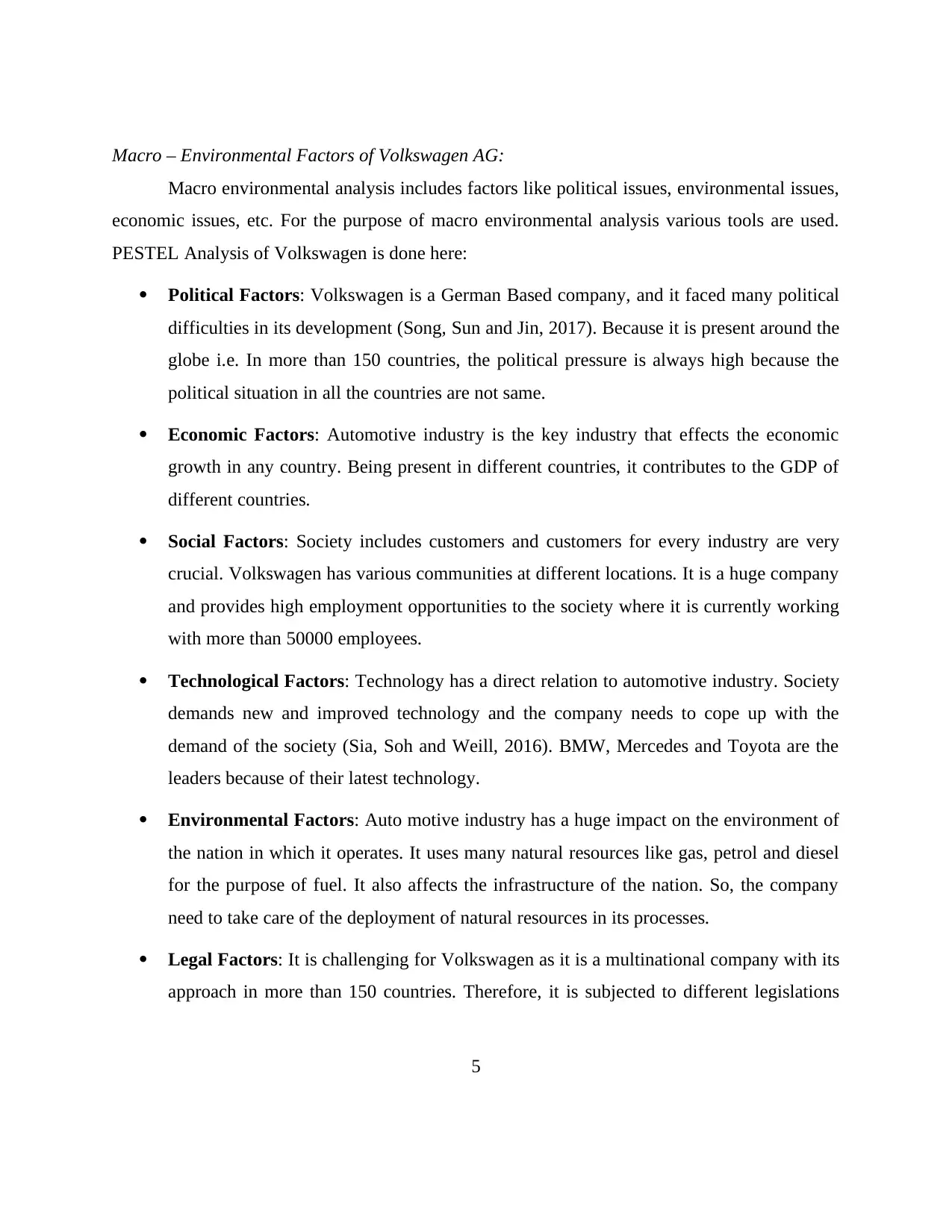
Macro – Environmental Factors of Volkswagen AG:
Macro environmental analysis includes factors like political issues, environmental issues,
economic issues, etc. For the purpose of macro environmental analysis various tools are used.
PESTEL Analysis of Volkswagen is done here:
Political Factors: Volkswagen is a German Based company, and it faced many political
difficulties in its development (Song, Sun and Jin, 2017). Because it is present around the
globe i.e. In more than 150 countries, the political pressure is always high because the
political situation in all the countries are not same.
Economic Factors: Automotive industry is the key industry that effects the economic
growth in any country. Being present in different countries, it contributes to the GDP of
different countries.
Social Factors: Society includes customers and customers for every industry are very
crucial. Volkswagen has various communities at different locations. It is a huge company
and provides high employment opportunities to the society where it is currently working
with more than 50000 employees.
Technological Factors: Technology has a direct relation to automotive industry. Society
demands new and improved technology and the company needs to cope up with the
demand of the society (Sia, Soh and Weill, 2016). BMW, Mercedes and Toyota are the
leaders because of their latest technology.
Environmental Factors: Auto motive industry has a huge impact on the environment of
the nation in which it operates. It uses many natural resources like gas, petrol and diesel
for the purpose of fuel. It also affects the infrastructure of the nation. So, the company
need to take care of the deployment of natural resources in its processes.
Legal Factors: It is challenging for Volkswagen as it is a multinational company with its
approach in more than 150 countries. Therefore, it is subjected to different legislations
5
Macro environmental analysis includes factors like political issues, environmental issues,
economic issues, etc. For the purpose of macro environmental analysis various tools are used.
PESTEL Analysis of Volkswagen is done here:
Political Factors: Volkswagen is a German Based company, and it faced many political
difficulties in its development (Song, Sun and Jin, 2017). Because it is present around the
globe i.e. In more than 150 countries, the political pressure is always high because the
political situation in all the countries are not same.
Economic Factors: Automotive industry is the key industry that effects the economic
growth in any country. Being present in different countries, it contributes to the GDP of
different countries.
Social Factors: Society includes customers and customers for every industry are very
crucial. Volkswagen has various communities at different locations. It is a huge company
and provides high employment opportunities to the society where it is currently working
with more than 50000 employees.
Technological Factors: Technology has a direct relation to automotive industry. Society
demands new and improved technology and the company needs to cope up with the
demand of the society (Sia, Soh and Weill, 2016). BMW, Mercedes and Toyota are the
leaders because of their latest technology.
Environmental Factors: Auto motive industry has a huge impact on the environment of
the nation in which it operates. It uses many natural resources like gas, petrol and diesel
for the purpose of fuel. It also affects the infrastructure of the nation. So, the company
need to take care of the deployment of natural resources in its processes.
Legal Factors: It is challenging for Volkswagen as it is a multinational company with its
approach in more than 150 countries. Therefore, it is subjected to different legislations
5
⊘ This is a preview!⊘
Do you want full access?
Subscribe today to unlock all pages.

Trusted by 1+ million students worldwide
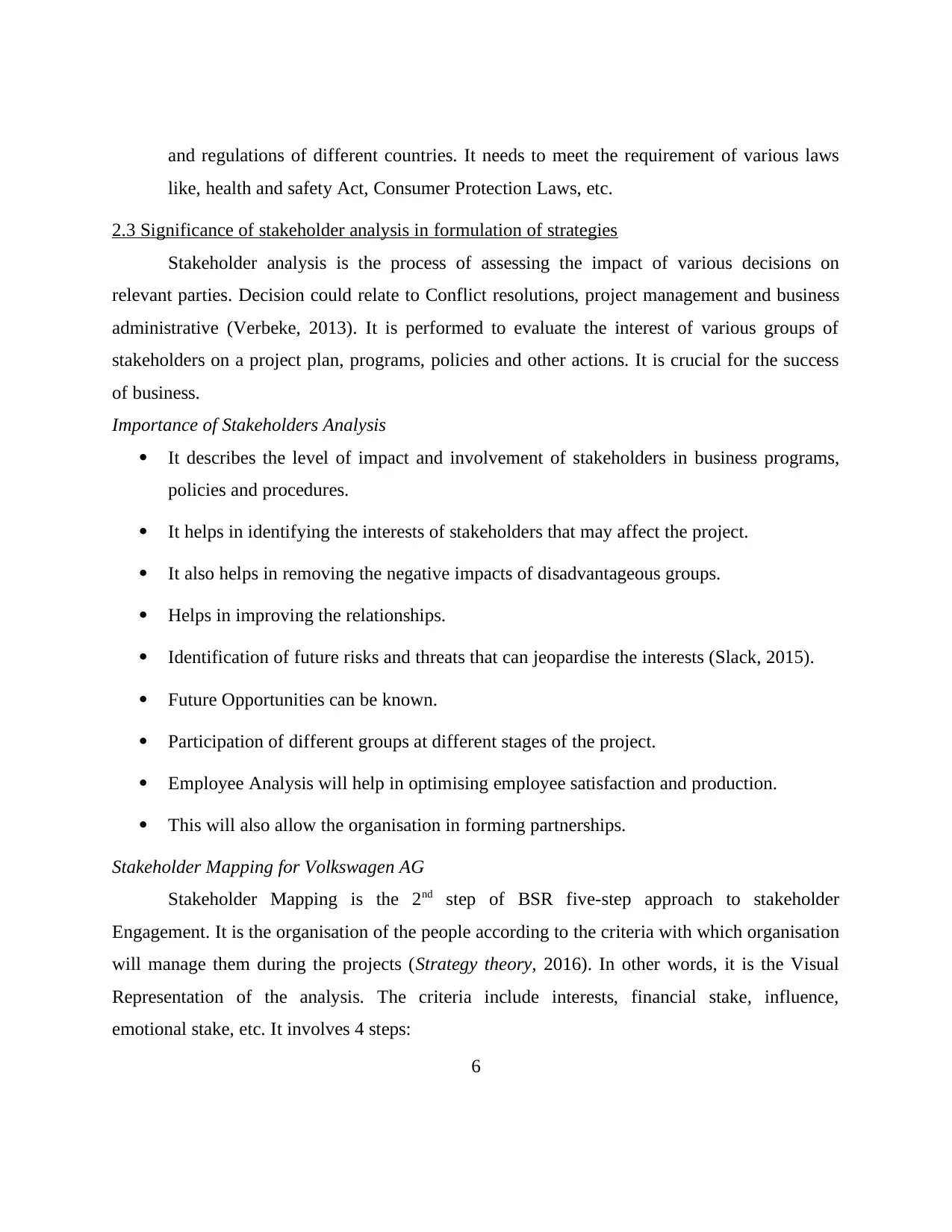
and regulations of different countries. It needs to meet the requirement of various laws
like, health and safety Act, Consumer Protection Laws, etc.
2.3 Significance of stakeholder analysis in formulation of strategies
Stakeholder analysis is the process of assessing the impact of various decisions on
relevant parties. Decision could relate to Conflict resolutions, project management and business
administrative (Verbeke, 2013). It is performed to evaluate the interest of various groups of
stakeholders on a project plan, programs, policies and other actions. It is crucial for the success
of business.
Importance of Stakeholders Analysis
It describes the level of impact and involvement of stakeholders in business programs,
policies and procedures.
It helps in identifying the interests of stakeholders that may affect the project.
It also helps in removing the negative impacts of disadvantageous groups.
Helps in improving the relationships.
Identification of future risks and threats that can jeopardise the interests (Slack, 2015).
Future Opportunities can be known.
Participation of different groups at different stages of the project.
Employee Analysis will help in optimising employee satisfaction and production.
This will also allow the organisation in forming partnerships.
Stakeholder Mapping for Volkswagen AG
Stakeholder Mapping is the 2nd step of BSR five-step approach to stakeholder
Engagement. It is the organisation of the people according to the criteria with which organisation
will manage them during the projects (Strategy theory, 2016). In other words, it is the Visual
Representation of the analysis. The criteria include interests, financial stake, influence,
emotional stake, etc. It involves 4 steps:
6
like, health and safety Act, Consumer Protection Laws, etc.
2.3 Significance of stakeholder analysis in formulation of strategies
Stakeholder analysis is the process of assessing the impact of various decisions on
relevant parties. Decision could relate to Conflict resolutions, project management and business
administrative (Verbeke, 2013). It is performed to evaluate the interest of various groups of
stakeholders on a project plan, programs, policies and other actions. It is crucial for the success
of business.
Importance of Stakeholders Analysis
It describes the level of impact and involvement of stakeholders in business programs,
policies and procedures.
It helps in identifying the interests of stakeholders that may affect the project.
It also helps in removing the negative impacts of disadvantageous groups.
Helps in improving the relationships.
Identification of future risks and threats that can jeopardise the interests (Slack, 2015).
Future Opportunities can be known.
Participation of different groups at different stages of the project.
Employee Analysis will help in optimising employee satisfaction and production.
This will also allow the organisation in forming partnerships.
Stakeholder Mapping for Volkswagen AG
Stakeholder Mapping is the 2nd step of BSR five-step approach to stakeholder
Engagement. It is the organisation of the people according to the criteria with which organisation
will manage them during the projects (Strategy theory, 2016). In other words, it is the Visual
Representation of the analysis. The criteria include interests, financial stake, influence,
emotional stake, etc. It involves 4 steps:
6
Paraphrase This Document
Need a fresh take? Get an instant paraphrase of this document with our AI Paraphraser
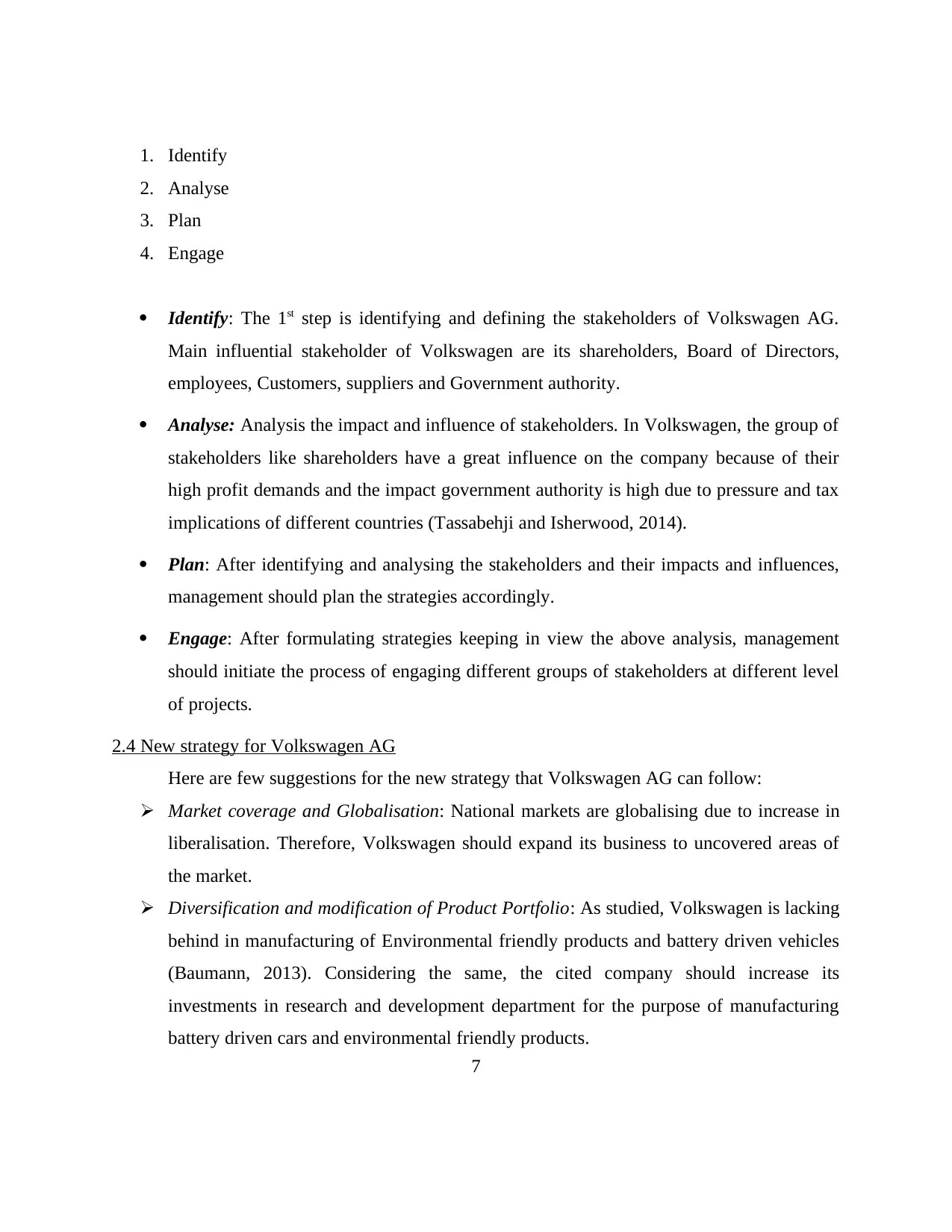
1. Identify
2. Analyse
3. Plan
4. Engage
Identify: The 1st step is identifying and defining the stakeholders of Volkswagen AG.
Main influential stakeholder of Volkswagen are its shareholders, Board of Directors,
employees, Customers, suppliers and Government authority.
Analyse: Analysis the impact and influence of stakeholders. In Volkswagen, the group of
stakeholders like shareholders have a great influence on the company because of their
high profit demands and the impact government authority is high due to pressure and tax
implications of different countries (Tassabehji and Isherwood, 2014).
Plan: After identifying and analysing the stakeholders and their impacts and influences,
management should plan the strategies accordingly.
Engage: After formulating strategies keeping in view the above analysis, management
should initiate the process of engaging different groups of stakeholders at different level
of projects.
2.4 New strategy for Volkswagen AG
Here are few suggestions for the new strategy that Volkswagen AG can follow:
Market coverage and Globalisation: National markets are globalising due to increase in
liberalisation. Therefore, Volkswagen should expand its business to uncovered areas of
the market.
Diversification and modification of Product Portfolio: As studied, Volkswagen is lacking
behind in manufacturing of Environmental friendly products and battery driven vehicles
(Baumann, 2013). Considering the same, the cited company should increase its
investments in research and development department for the purpose of manufacturing
battery driven cars and environmental friendly products.
7
2. Analyse
3. Plan
4. Engage
Identify: The 1st step is identifying and defining the stakeholders of Volkswagen AG.
Main influential stakeholder of Volkswagen are its shareholders, Board of Directors,
employees, Customers, suppliers and Government authority.
Analyse: Analysis the impact and influence of stakeholders. In Volkswagen, the group of
stakeholders like shareholders have a great influence on the company because of their
high profit demands and the impact government authority is high due to pressure and tax
implications of different countries (Tassabehji and Isherwood, 2014).
Plan: After identifying and analysing the stakeholders and their impacts and influences,
management should plan the strategies accordingly.
Engage: After formulating strategies keeping in view the above analysis, management
should initiate the process of engaging different groups of stakeholders at different level
of projects.
2.4 New strategy for Volkswagen AG
Here are few suggestions for the new strategy that Volkswagen AG can follow:
Market coverage and Globalisation: National markets are globalising due to increase in
liberalisation. Therefore, Volkswagen should expand its business to uncovered areas of
the market.
Diversification and modification of Product Portfolio: As studied, Volkswagen is lacking
behind in manufacturing of Environmental friendly products and battery driven vehicles
(Baumann, 2013). Considering the same, the cited company should increase its
investments in research and development department for the purpose of manufacturing
battery driven cars and environmental friendly products.
7
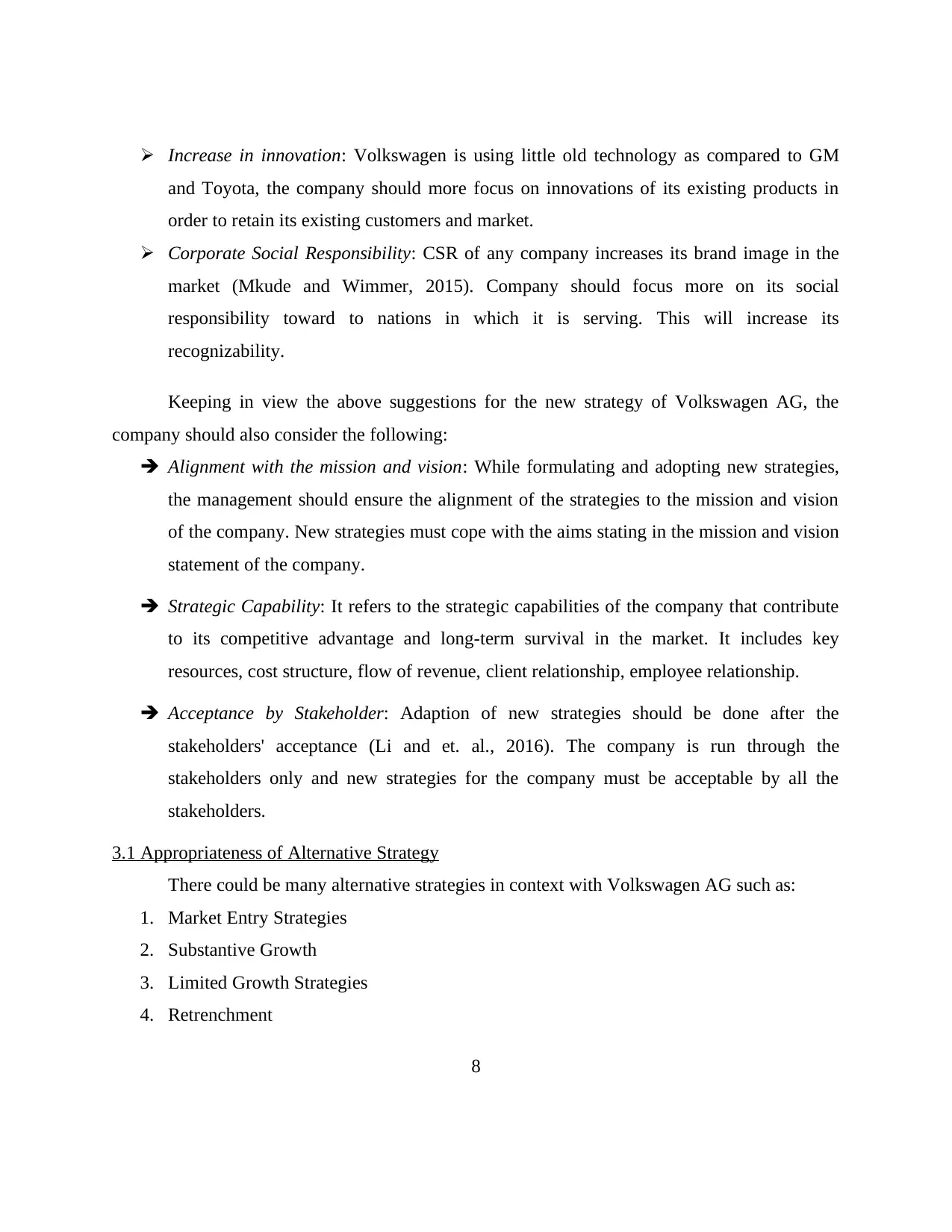
Increase in innovation: Volkswagen is using little old technology as compared to GM
and Toyota, the company should more focus on innovations of its existing products in
order to retain its existing customers and market.
Corporate Social Responsibility: CSR of any company increases its brand image in the
market (Mkude and Wimmer, 2015). Company should focus more on its social
responsibility toward to nations in which it is serving. This will increase its
recognizability.
Keeping in view the above suggestions for the new strategy of Volkswagen AG, the
company should also consider the following:
Alignment with the mission and vision: While formulating and adopting new strategies,
the management should ensure the alignment of the strategies to the mission and vision
of the company. New strategies must cope with the aims stating in the mission and vision
statement of the company.
Strategic Capability: It refers to the strategic capabilities of the company that contribute
to its competitive advantage and long-term survival in the market. It includes key
resources, cost structure, flow of revenue, client relationship, employee relationship.
Acceptance by Stakeholder: Adaption of new strategies should be done after the
stakeholders' acceptance (Li and et. al., 2016). The company is run through the
stakeholders only and new strategies for the company must be acceptable by all the
stakeholders.
3.1 Appropriateness of Alternative Strategy
There could be many alternative strategies in context with Volkswagen AG such as:
1. Market Entry Strategies
2. Substantive Growth
3. Limited Growth Strategies
4. Retrenchment
8
and Toyota, the company should more focus on innovations of its existing products in
order to retain its existing customers and market.
Corporate Social Responsibility: CSR of any company increases its brand image in the
market (Mkude and Wimmer, 2015). Company should focus more on its social
responsibility toward to nations in which it is serving. This will increase its
recognizability.
Keeping in view the above suggestions for the new strategy of Volkswagen AG, the
company should also consider the following:
Alignment with the mission and vision: While formulating and adopting new strategies,
the management should ensure the alignment of the strategies to the mission and vision
of the company. New strategies must cope with the aims stating in the mission and vision
statement of the company.
Strategic Capability: It refers to the strategic capabilities of the company that contribute
to its competitive advantage and long-term survival in the market. It includes key
resources, cost structure, flow of revenue, client relationship, employee relationship.
Acceptance by Stakeholder: Adaption of new strategies should be done after the
stakeholders' acceptance (Li and et. al., 2016). The company is run through the
stakeholders only and new strategies for the company must be acceptable by all the
stakeholders.
3.1 Appropriateness of Alternative Strategy
There could be many alternative strategies in context with Volkswagen AG such as:
1. Market Entry Strategies
2. Substantive Growth
3. Limited Growth Strategies
4. Retrenchment
8
⊘ This is a preview!⊘
Do you want full access?
Subscribe today to unlock all pages.

Trusted by 1+ million students worldwide
1 out of 20
Related Documents
Your All-in-One AI-Powered Toolkit for Academic Success.
+13062052269
info@desklib.com
Available 24*7 on WhatsApp / Email
![[object Object]](/_next/static/media/star-bottom.7253800d.svg)
Unlock your academic potential
Copyright © 2020–2025 A2Z Services. All Rights Reserved. Developed and managed by ZUCOL.





